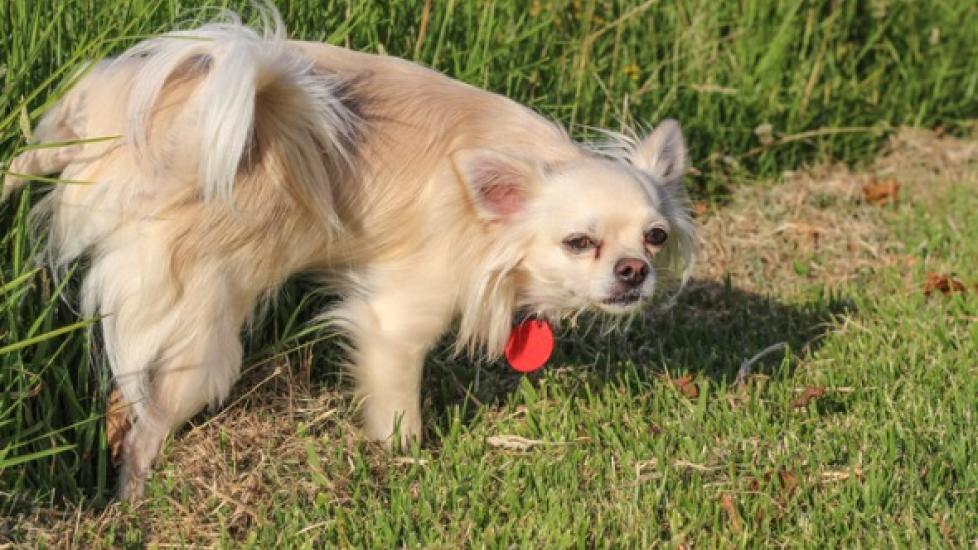Why Do Dogs Lift Their Leg to Pee?
You may have been surfing the internet and stumbled across a hilarious video of a pug urinating while doing a handstand. While this is indeed funny, it is actually one of 12 distinct elimination postures dogs use while peeing.
The handstand, among some of the more popular options like the “raise” and “squat” positions, were all documented in a 1970s study on canine elimination patterns.
Conventionally, it is thought that a male dog lifts his leg to urinate and a female dog squats. Because this is statistically true, it often leads pet parents to believe that any male that does not lift his leg, or any female that does not squat, has a behavioral or medical issue.
Let’s find out what’s behind the urge for dogs to lift their leg to pee.
Why Dogs Raise Their Legs to Urinate
So, what is it that causes a male dog or even a female dog to raise their leg? Thankfully, science has given us an answer.
With both male and female dogs, urination serves two distinct purposes: eliminating liquid waste and marking territory. Male dogs are much more likely to scent-mark, which contributes to their occasional preference for a leg-lifting position. Lifting a leg makes it easier to urinate on higher surfaces like trees or fire hydrants and cover a larger area, which leaves a stronger message than urine on the ground.
Do All Male Dogs Lift Their Legs to Pee?
Leg-lifting or leg-raising is not a born habit in the majority of pups. A 2018 research article written in part by Dr. Betty McGuire, who has a PhD in ecology and evolutionary biology from Cornell University, studied scent-marking in shelter pets.
The study showed that there are two predominant postures that a male dog will utilize for urination: the classic leg lift and a position known as the juvenile lean posture or the “racehorse” stance.
Most male dogs start with the “lean” stance, where both hind limbs stay on the ground, the body leans forward, and the hind legs are extended back.
As a male dog starts to reach maturity, he will increasingly lift his leg while urinating. Sexual maturity in puppies usually starts in male pups around the 6-month mark in small breeds, and up to around 9 months in medium to large breeds, and it may not occur until over a year in some giant breeds.
You can, however, influence how a male dog will urinate. Often, working dogs (like seeing eye dogs or bomb-sniffing dogs) are trained to not mark their territory to avoid having them urinate on surfaces where you don’t want them to urinate.
Even if you don’t have a working dog, if you want to keep the vertical surfaces around your home and yard clean, you can encourage your pup to not lift their legs to pee. Keeping young male pups away from vertical surfaces when they urinate can help prevent them from starting the leg-lifting behavior.
Why Do Some Female Dogs Lift Their Leg to Pee?
Male dogs are not the only ones who mark their territory with urine. Scent-marking is a common form of communication used by most mammals in both sexes.
In a paper published in 2004 looking at urination habits among female dogs, researchers found that the farther away from home the female dogs were, the more likely they were to urinate frequently and aim their urine at objects. This same study found that there were two prominent urination postures for female dogs—the ever-popular squat, and the combination of a squat and a leg-lift, called a “squat-raise.”
So, while male dogs are more likely to urinate to mark their territory, it is not uncommon for female dogs to lift their leg to leave a message for the next pup who comes along.
What If My Male Dog Doesn't Lift Their Leg to Pee?
There are multiple urination positions that are normal for male dogs—the leg lift is just one of them. The urination stance they use depends on a number of factors, including their situation and even their breed. Most dogs have solidified their preference for a stance by adulthood.
It’s also possible that dogs will change their urination posture in response to stress. In the shelter study conducted by Dr. McGuire, she observed that dogs in high-stress situations, such as having been recently adopted, may revert to a lean-posture stance. Many dogs will also have an ambidextrous or ambilateral nature to their stance, meaning they will lift their left or right leg interchangeably.
If your male (or female) dog changes their urination position, it may be a sign of a medical concern, like joint pain or a urinary tract issue. If your dog has changed their urination stance, take them to see your veterinarian to make sure there isn’t an underlying health issue.
Is It True That Small Dogs Lift Their Legs Higher When They Pee?
Scent-marking in dogs, according to Dr. McGuire, communicates information about the dog, including their size and their potential competitive ability. In her study, she found that the smaller the dog, the more likely they were to raise their leg at a higher angle and therefore urinate higher on a vertical surface.
“It might be uniquely beneficial for small dogs to exaggerate their body size and competitive abilities through relatively high scent marks if this enables them to avoid direct conflict,” writes Dr. McGuire. “In contrast, large dogs, with greater competitive abilities, would have less incentive to avoid direct conflict.”
Therefore, little dogs are more likely to urinate higher on surfaces to present themselves as larger dogs and potentially tougher competitors. However your dog might choose to urinate, be mindful of their regular positioning and keep your veterinarian in the loop should anything change.
Featured Image: iStock.com/misscherrygolightly
